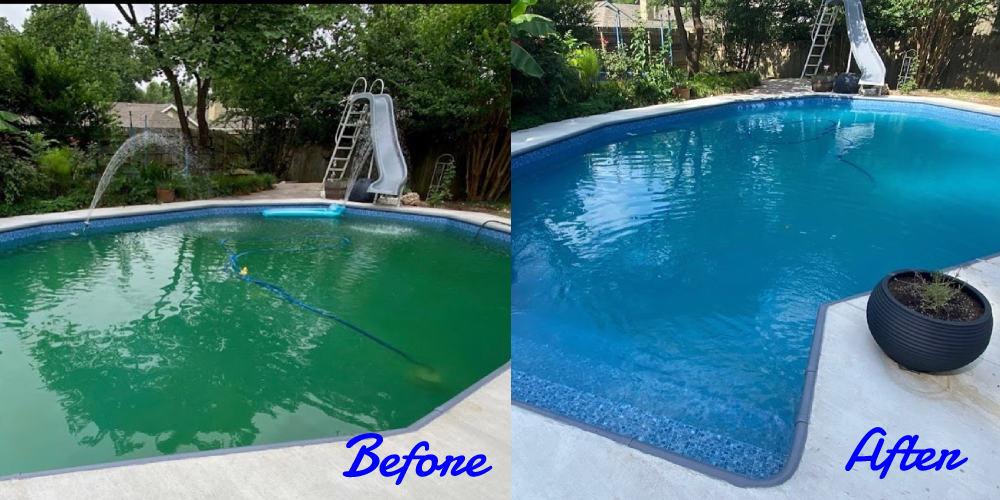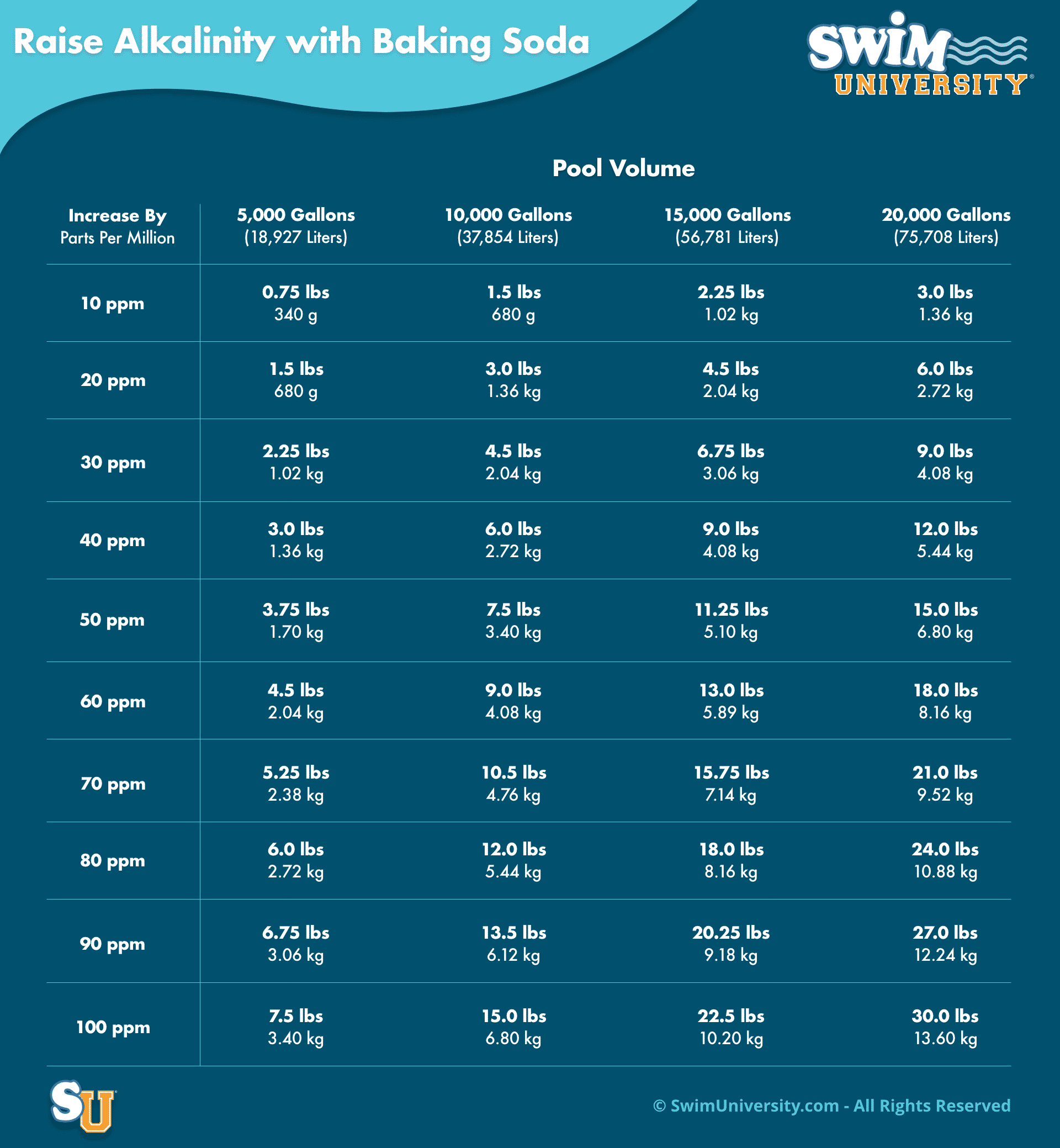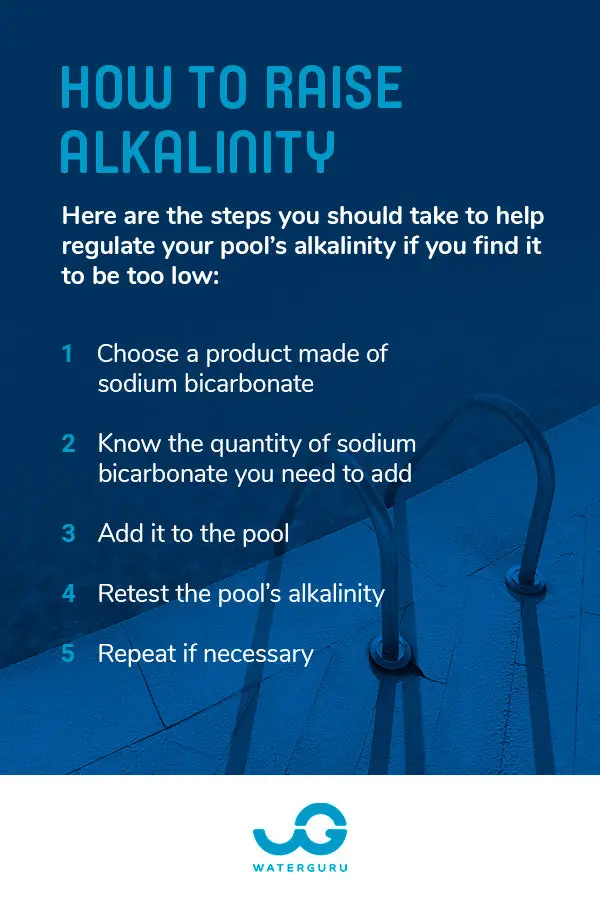To raise alkalinity in a pool, you can use baking soda or an alkalinity increaser. Baking soda is commonly used as it is easily accessible and affordable.
A balanced alkalinity level is vital for maintaining the overall water quality and stability of a swimming pool. Alkalinity refers to the ability of water to resist changes in pH levels. If the alkalinity is too low, the water becomes acidic and can damage the pool’s infrastructure, cause eye irritation, and corrode equipment.
Fortunately, increasing alkalinity is a straightforward process. Two effective options are using baking soda or an alkalinity increaser. Baking soda is a household item that can be easily found at local stores, making it a convenient choice for pool owners. On the other hand, an alkalinity increaser is a specifically formulated product designed to raise alkalinity levels in pools.
Testing Alkalinity Levels
Testing the alkalinity levels in your pool is an essential step in maintaining balanced water chemistry. Imbalanced alkalinity levels can lead to corrosion, scale buildup, and inefficient chlorine performance. By regularly testing the alkalinity levels, you can ensure that your pool water remains safe, comfortable, and properly balanced.
Using Test Strips
Test strips are a convenient and widely-used method for testing pool water alkalinity levels. To perform the test, simply dip the strip into the pool water and compare the color change to the provided chart. Ensure the strip is fully submerged for an accurate reading. Test strips provide a quick way to gauge the alkalinity levels, allowing for immediate adjustments if necessary.
Utilizing Liquid Test Kits
Liquid test kits offer a more precise measurement of pool water alkalinity. These kits typically include reagents that are added to a water sample, causing a color change based on the alkalinity level. Follow the instructions carefully and accurately measure the reagent amounts for an accurate reading. Liquid test kits are ideal for those who require a more detailed understanding of their pool water chemistry.

Credit: www.docdeanspools.com
Increasing Alkalinity
To increase alkalinity in a pool, consider using baking soda or alkalinity increaser. Test levels frequently to maintain balance. Consult a pool professional for guidance on the correct dosage and application methods.
Increasing the alkalinity in your pool is essential for maintaining balanced water chemistry and preventing corrosion and other issues. When the alkalinity levels are too low, the pH levels can fluctuate, leading to potential damage to the pool and discomfort for swimmers. Here are some effective methods to increase the alkalinity in your pool.Using Baking Soda
Baking soda, also known as sodium bicarbonate, is an accessible and cost-effective way to raise alkalinity in your pool. When added in the appropriate quantities, it can effectively increase the alkalinity without significantly impacting the pH levels. To use baking soda, start by measuring the current alkalinity level of the pool water using a testing kit. Then, refer to a pool maintenance guide to determine the amount of baking soda needed to raise the alkalinity to the desired range.Applying Alkalinity Increaser Chemicals
Alkalinity increaser chemicals are specially formulated products designed to raise the alkalinity levels in pools. These chemicals are available in granular or liquid form. When using alkalinity increaser chemicals, it’s crucial to follow the manufacturer’s instructions precisely to avoid over-treating the water. Start by carefully measuring the pool’s current alkalinity level and then add the recommended amount of the alkalinity increaser directly to the water while the pump is running to ensure proper distribution. Increasing the alkalinity of your pool is a straightforward process that contributes to maintaining a safe and enjoyable swimming environment. By utilizing these methods, you can effectively raise the alkalinity levels in your pool and promote optimal water balance.Maintaining Alkalinity
Maintaining the proper alkalinity levels in your pool is crucial for ensuring the water stays balanced and safe for swimming. Alkalinity refers to the measure of minerals, mainly bicarbonates, in the water. If the alkalinity levels are too low, it can lead to corrosive water, while excessively high levels can cause cloudy water and scale buildup. To keep your pool’s alkalinity in check and create a comfortable swimming experience, follow these essential steps.
Regular Testing And Adjustment
Regular testing of the pool water is key to maintaining optimal alkalinity levels. You can use a testing kit designed specifically for checking alkalinity, or bring a water sample to your local pool supply store for analysis. Testing the water at least once a week can help you catch any fluctuations early on and take appropriate action. The ideal alkalinity range for a pool is typically between 80 and 120 parts per million (ppm). If the test results show that the alkalinity is low, you can easily raise them by adding an alkalinity increaser, such as sodium bicarbonate, to the water. On the other hand, if the levels are too high, you can lower them using muriatic acid or sodium bisulfate. Always follow the manufacturer’s instructions and use the appropriate amount of chemicals.
Preventing Fluctuations
Preventing extreme fluctuations in alkalinity levels is crucial for maintaining a stable pool environment. Rapid changes in alkalinity can cause pH imbalances and other issues. To prevent fluctuations, make sure to maintain proper chemical levels and keep a close eye on your pool’s alkalinity. Regularly checking and adjusting the alkalinity levels, as mentioned earlier, will help you prevent any sudden changes and maintain a healthy and balanced pool environment. Additionally, it’s important to note that proper circulation and filtration of the pool water can also help maintain alkalinity levels. The consistent turnover of water through the filtration system ensures that any imbalances are properly distributed and regulated.
By following these steps, you can effectively maintain the alkalinity in your pool and provide a safe and enjoyable swimming experience for everyone.

Credit: theelitepool.com
Factors Affecting Alkalinity
Understanding the factors that influence alkalinity in your pool is vital for maintaining clear and balanced water. Several key elements contribute to the alkalinity levels, including pH levels and pool usage habits.
Impact Of Ph Levels
pH levels directly impact the alkalinity of your pool, as they measure the acidity or basicity of the water. A pH level above 7.6 can lead to high alkalinity, while a lower pH indicates low alkalinity, affecting the overall water balance.
Influence Of Pool Usage
The frequency and intensity of pool usage can affect alkalinity levels, as swimmers introduce contaminants that alter the water chemistry. Heavy pool usage may cause a drop in alkalinity, requiring regular monitoring and adjustments to maintain a healthy pH balance.
Professional Help
If you’re having trouble managing the alkalinity levels in your pool, seeking professional help can save you time and effort. Consulting with pool service experts or hiring a pool maintenance company can provide you with the expertise and resources needed to effectively raise the alkalinity in your pool.
Consulting Pool Service Experts
Pool service experts are well-equipped to assess your pool’s alkalinity levels and recommend the best course of action. They can conduct comprehensive tests and provide tailored solutions to address any imbalances. By hiring a pool service expert, you can ensure that your pool’s alkalinity is corrected efficiently and effectively.
Hiring A Pool Maintenance Company
When facing challenges with alkalinity levels, enlisting the help of a pool maintenance company can offer a comprehensive approach to maintaining your pool’s chemistry. These professionals have the knowledge and experience to adjust alkalinity levels while also addressing other vital aspects of pool maintenance. Hiring a pool maintenance company can provide ongoing support in managing your pool’s alkalinity, ensuring it remains balanced over time.
Precautions And Safety
When it comes to maintaining a pool’s alkalinity, it’s essential to prioritize safety and take necessary precautions. Proper handling of chemicals and wearing protective gear are critical steps in ensuring a safe environment for pool maintenance. By following these precautions, you can effectively raise the alkalinity in your pool without compromising on safety.
Wearing Protective Gear
Wearing appropriate protective gear is crucial when working with pool chemicals. This includes wearing gloves, safety goggles, and a mask to prevent direct contact with the skin, eyes, and respiratory system. By wearing this protective gear, you can minimize the risk of exposure to potentially harmful chemicals and ensure your well-being while adjusting the alkalinity level of your pool.
Proper Chemical Handling
Properly handling pool chemicals is essential to avoid accidents and injuries. Always read and follow the manufacturer’s instructions when handling any pool chemicals. Store the chemicals in a cool, dry place away from direct sunlight and moisture. Additionally, ensure that the containers are tightly sealed to prevent any leaks or spills. When adding chemicals to the pool, pour them slowly and steadily to prevent splashing and minimize the risk of accidental exposure.

Credit: www.swimuniversity.com
Conclusion
Maintaining the proper alkalinity level in your pool is crucial for water balance. By following the steps outlined in this guide, you can easily raise the alkalinity in your pool. Remember to test and adjust levels regularly for a clean and refreshing swimming experience.
Keep your pool pristine and sparkling!





